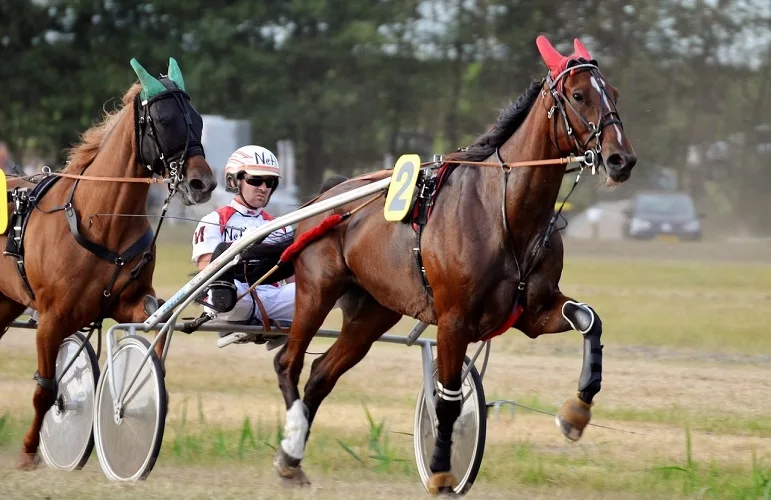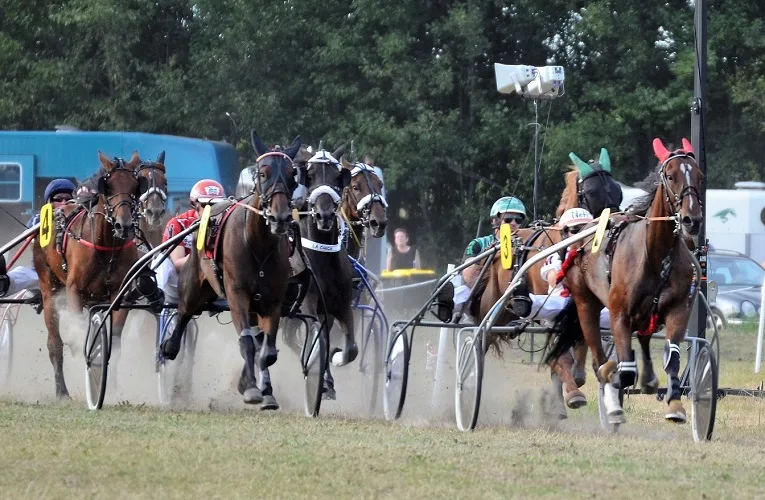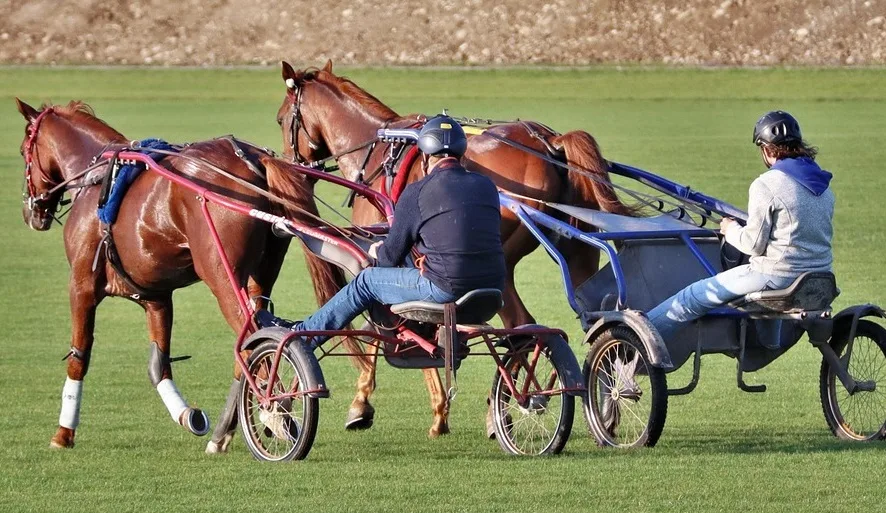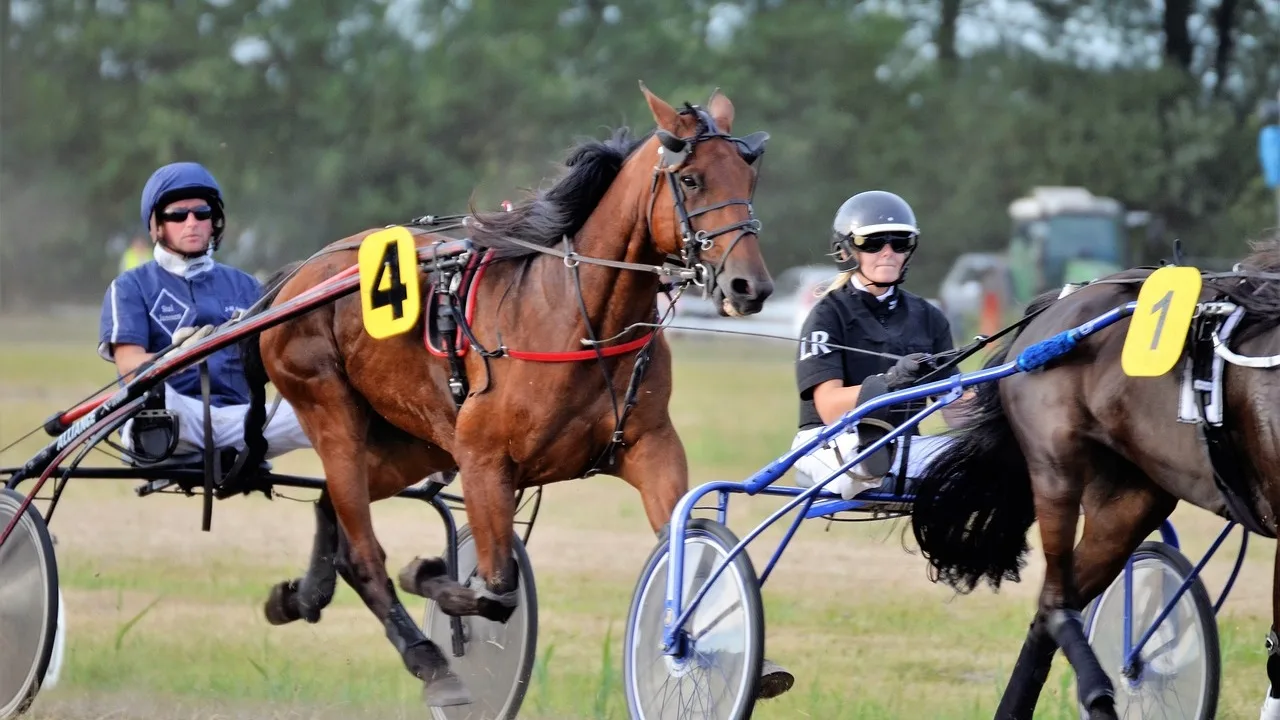This post may contain affiliate links. We earn from qualifying purchases. Learn More
Horse racing has long been a popular sport across the world. While people are familiar with the long-standing tradition of Thoroughbred racing, many know little about the world of harness racing.
Though it may not be as popular as Thoroughbred horse racing, harness racing has a long, rich history. The origins of harness racing date back to 1500 BC when Assyrian kings used horses to drive chariots for both war and sport.
In the 7th century BC, chariot races were held at the Olympic Games. The sport then rose to popularity throughout Greece and Rome. However, the fall of the Roman Empire brought the end of chariot racing.
As early as 1554, a horse fair in Valkenburg in Holland held trotting matches, beginning the rise of what would become modern harness racing. During this time, trotting horses were becoming increasingly popular in Russia.
While North America has a long history of road racing, the first harness tracks were opened in the early 19th century. Harness racing was soon a thriving sport across America and Canada at agricultural and county fairs.
By 1840, trotting races had become an organized sport in New England. The sport then grew in popularity across the world, including France, Germany, Belgium, Sweden, and Austria. The sport eventually made its way to Australia and New Zealand where it still remains a beloved pastime.
What is Harness Racing?
Harness racing is a type of horse racing where a horse pulls a vehicle called a sulky. The person controlling the horse is known as a driver, not a jockey. Racing takes place on a track and the horses compete at a trot or a pace.
A sulky is a lightweight two-wheeled vehicle that is designed to seat just one person. The shafts of the sulky attach to the harness the horse wears. They are also known as a bike, gig, or spider.

Sulkies typically come in two types: jog carts and racing bikes. Jog carts are used for training and are typically heavier. Racing bikes are more aerodynamic with a small seat and stirrups for the driver.
The driver uses the reins and a whip to control the horse. Drivers must be athletic and skillful, being able to maintain a proper posture and use their seat to their advantage. Like with flat racing and steeplechases, a great amount of strategy is required to win a race.
Unlike flat racing, most harness races utilize a motorized starting gate, also known as the mobile barrier. A vehicle pulls a pair of retractable metal wings and drives off slowly, getting the horses off to an even running start before accelerating away and off the track.
Harness horses must be at least two years old before they can begin racing. Some harness racehorses will have careers into their teens.
What Are the Rules of Harness Racing?
The rules of harness racing vary from country to country, but there are some general rules that apply to all harness racing events. Horses must be at least 3 years old to race. They must also be registered with a harness racing organization. Harness racing races are typically 1 mile or 1.5 miles long.
The horses must start from a standing start and race around a track in a clockwise direction. The horse that crosses the finish line first wins the race.
How Long are Harness Races?
Most harness races last for one mile. They take place on different size tracks, most commonly ½ mile, ⅝ mile, or one mile long.
In most cases, harness racing takes place on tracks specifically designed for harness racing. However, some tracks host both harness racing and Thoroughbred flat racing.
What Are the Different Harness Racing Tracks?
Harness racing tracks are typically oval-shaped and made of dirt or synthetic material. They have a starting gate at one end of the track and a finish line at the other end. Harness racing tracks can be indoor or outdoor.
Types of Harness Racing
There are two types of harness racing: trotting and pacing. If a horse is a trotter it will only compete in trotting races and if a horse is a pacer it will only compete in pacing races.
In continental Europe, races are exclusively for trotters, whereas in Australia, Canada, New Zealand, the United Kingdom, and the United States there are both trotting and pacing races.

Typically, pacers are faster than trotters. If a horse switches from a trot or a pace in a race it may be disqualified.
Trotters
Trotters will compete exclusively at a trot. A trot is a diagonal gait (the right front and left hind, then left front and right hind, striking the ground simultaneously).
Pacers
Pacers compete at a pace, which is a lateral gait (the right front and right hind together, then left front and left hind). About 85% of harness races in North America are for pacers.
Pacers are less likely to break gait than trotters. They often wear a special type of equipment known as a hobble that helps them maintain a pace. A hobble is a strap that connects the legs on each of the horse’s sides.
What Is a Sulky?
A sulky is a lightweight, two-wheeled cart that is pulled by a horse. It is used in harness racing, a sport in which horses race against each other while pulling sulkies. Sulkies are also used for pleasure riding and driving.
The name “sulky” is thought to have originated in the early 19th century. It is believed to be derived from the Old English word “solcen,” which means “curved.” This is likely because the early sulkies were curved in shape.
Sulklys are typically made of wood or metal, and they have a single seat for the driver. They are also equipped with a harness that attaches to the horse. Sulkys can be lightweight or heavy, depending on the type of racing they are used for.
In harness racing, sulkys are used to give the horses a more aerodynamic advantage. The lightweight design of the sulky allows the horse to move more freely, which can help them to run faster.

Sulklys are also used for pleasure riding and driving. They are a popular choice for people who want to enjoy a leisurely ride in the countryside.
Here are some of the different types of sulkies:
- Standard sulky: This is the most common type of sulky and is used in most types of harness racing. It is a lightweight, two-wheeled cart that is pulled by a single horse.
- Bike sulky: This type of sulky is pulled by a bicycle. It is a smaller and lighter than a standard sulky and is often used for pleasure riding.
- Dog sulky: This type of sulky is pulled by a dog. It is similar to a standard sulky, but it is smaller and lighter to accommodate the dog.
- Quad sulky: This type of sulky is pulled by four horses. It is used in harness racing competitions for four-in-hand teams.
Which Is Faster, the Pacer or the Trotter?
Pacers are generally faster than trotters. A pacer moves its legs in a diagonal gait, with its right front leg and left hind leg moving forward at the same time, and vice versa. This allows the horse to move its legs more smoothly and efficiently, which can lead to faster speeds.
A trotter moves its legs in a lateral gait, with its left front leg and right hind leg moving forward at the same time, and vice versa. This gait is less efficient than the pacing gait, and can lead to slower speeds.
However, there are some trotters that can be faster than pacers. This is usually because the trotter has a very long stride, which can allow it to cover more ground in a single step.
What Breeds Compete in Harness Racing?
Different breeds of horses are used for horse racing across the world. Horses used for harness racing are often exclusively bred for the sport.
In North America, harness racing is exclusive to Standardbreds, with Standardbreds also used in the UK, Australia, and New Zealand. Throughout Europe, French Trotters and Russian Trotters are among the most common trotting horses, with Orlov Trotters competing separately in Russia. Scandinavian Coldblood Trotter and Finnish Horses race separately in Finland, Norway, and Sweden.
Here are some of the most common horse breeds used for harness racing.
Standardbred
The Standardbred is known for its excellent stamina and athleticism. They have well-muscled, long bodies with powerful hindquarters and shoulders. Standardbreds typically stand between 14-17 hands tall, weighing around 800-1,000 pounds.
Standardbreds are best known for their harness racing capabilities but they can also excel in a variety of riding disciplines. They developed in New England with bloodlines reaching back to the 18th century. Foundation stock for the breed includes the Narragansett Pacer, Canadian Pacer, Thoroughbred, Norfolk Trotter, Hackney, and Morgan.
The name Standardbred comes from the standard time of 2 minutes and 30 seconds that a horse had to complete a mile in to qualify for the registry. Standardbreds can compete as trotters or pacers.
French Trotter
The French Trotter was developed in Normandy during the 1800s. Breeders crossed Norman stock with Thoroughbred, Standardbred, Hackney, Norfolk Roadster, and hunter-type bloodlines. This resulted in a fast trotting horse with excellent stamina.
French Trotters typically stand between 15.1-17.1 hands tall and weigh around 1,000 to 1,100 pounds. They have well-set necks, powerful hindquarters, and strong backs. In addition to harness racing, they are also used for ridden trotting races, jumping, hunter pleasure, and skijoring.
Orlov Trotter
The Orlov Trotter was developed in Russia by Count A.G. Orlov between 1775 and 1784. Arabian horses were bred with the Dutch, Danish, and Mecklenburg harness breeds to help create the Orlov Trotter. The breed was developed to create a light harness horse that exhibited both speed and endurance.
Orlov Trotters stand between 15.2- 17 hands tall and weigh around 900-1,000 pounds. They have muscular legs, strong legs, and long, naturally arched necks. While Orlov Trotters excel in harness racing they are also used for agricultural work and riding.
Russian Trotter
After the American-bred Standardbred began dominating the Russian-bred Orlov Trotter on Russian racetracks racing prohibitions were created against foreign-bred horses. To combat this, Russian horse breeders crossed the Orlov Trotter with the faster Standardbred to create the Russian Trotter.
Russian Trotters stand around 16 hands tall and have athletic builds, strong legs, and muscular legs. While their primary use is harness racing, they are also used for riding as well.
Finnish Horse
The Finnish Horse, also known as the Finnhorse or the Finnish Universal Horse, is the national horse breed of Finland. While records of Finnish horses date back to the 13th century, the breed became official in 1907 when the studbook was developed.
Finnish Horses are descendants of northern European domestic horses with influence from both warmblood and draft breeds. They stand between 14.2 to 15.3 hands, with strong builds and good muscling. Finnish Horses have four different types: trotting, riding, pony type, and work horse (draught).
Finnish horses are a versatile breed, which gained them the name Finnish Universal Horse. They excel at harness racing, driving, jumping, dressage, draught work, and more.
Scandinavian Coldblood Trotter
The Scandinavian Coldblood Trotter consists of the Norsk Kaldblodstraver or Norwegian Coldblood Trotter and the Svensk Kallblodstravare or the Swedish Coldblood Trotter. They are two closely related and interconnected trotting horse breeds.
Coldblood Trotters come from cross-breeding native coldblooded farm horses, such as the Dølehest and North Swedish Horse, with lighter, faster horses. While Norwegian and Swedish Coldblood trotters are commonly considered one breed, they have two national studbooks.
Coldblood Trotters typically stand around 15 hands tall with small, compact muscular builds. Their primary use is for harness racing but they can also be riding horses as well.
Famous Harness Races
While not as popular as it once was, harness racing mains a staple around the world. In America, over 20 states host harness races.
Hambletonian
The Hambletonian Stakes is a major harness race for three-year-old trotting horses in America. The race is named after Hambletonian 10, a foundation sire of the Standardbred horse breed.
It is the first race in the harness racing Triple Crown for trotters, with the other two races being the Yonkers Trot, and Kentucky Futurity. The Hambletonian takes place at the Meadowlands Racetrack in East Rutherford, New Jersey, on the first Saturday in August.
Little Brown Jug
The Little Brown Jug is a premiere harness race for three-year-old pacers. The race is named after the pacer Standardbred that won nine consecutive races.
The Little Brown Jug is held at the Delaware County Fairgrounds racetrack in Delaware, Ohio the third Thursday after Labor Day. It is a part of the harness racing Triple Crown for pacers, with the other two races being the Cane Pace and Messenger Stakes.
Prix d’Amérique
The Prix d’Amérique is considered the most prestigious harness race in the world. It is held at the Hippodrome de Vincennes in Paris, France, and takes place on the last Sunday of January.
The trotting race was founded to honor the American troops’ contribution to France during WWI. It is considered the World Championship of harnessed trotting.
Inter Dominion
The Inter Dominion is a harness racing competition in Australia and New Zealand. It consists of two series: the Inter Dominion Pacing Championship and the Inter Dominion Trotting Championship. It is the biggest harness racing competition for Australia and New Zealand.
Gran Premio Lotteria di Agnano
The Gran Premio Lotteria di Agnano is a Group One harness competition that takes place at Agnano Racetrack in Naples, Italy. It is one of the most prestigious international events in trotting, with competitors coming from all over. The winner is decided by three qualifying heats and a subsequent final.

